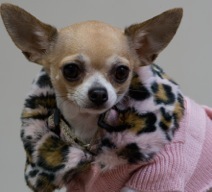(Teach Yourself Visual Dog Training, Sarah Hodgson; Wiley and Sons Publishing, 2005).
A lot of what I teach boils down to one simple rule: dogs and their owners should not stare. Dogs shouldn't stare down people or other dogs, and people shouldn't glare at dogs, unless it is to convey mutual adoration or invite play, which I confess to doing all the time.
Of course, we humans learn the staring rule before we're out of diapers. Staring is rude.
The problem for dogs is that few people teach this lesson, and it leads to a host of problems from leash aggression to jumping. I want to change that.
Take a few random dog behaviors that cause frustration, like a dog who steals from the counter, chases kids on bikes, or barks at delivery people. Puppies get in trouble too for routine acts like nipping, chewing, and jumping up.
Seconds before the misdeed the dog is doing what? Staring, at the biker, visitor, counter, or in the case of the mischievous puppy-the passing slipper. And what is the dog owner doing to discourage the behavior? Staring at the dog, who is staring at the object, person, or other dog. It's viscous cycle, canine style.
What to do?
To resolve these issues, you need to change your dog's focus, and in some cases, proof the environment to reduce temptations. It's less complicated than it sounds. Take this latest case I worked on-test your canine IQ. What sounded disastrous on the phone, was easy to resolve.
Meet Blanche, an 8-pound, 4-year-old Chihuahua with a serious attitude problem. At home she barks continuously when left alone and whenever dogs pass by her window perch. On walks she pulls like a husky, using her best menacing stare-bark combo to intimidate other dogs. The neighbors would be more terrified if she were any bigger than a toaster oven.
While Jack, her owner, finds her ferocity entertaining, Blanche finally got her comeuppance when Clifford--the big red-boned Pit Bull terrier - moved in next door. Though Clifford himself was an ambassador of good behavior and got along with most other dogs, he was not impressed with Blanche's Napoleonic display. One chance meeting on the elevator resulted in a dispute that quickly got Blanche's attention. When Blanche issued her stare-bark, Clifford barked menacingly back causing Blanche to yelp in terror.
I thought that was going to cure her," Jack said to me, "but Blanche's gotten worse, frantically staring and barking at every dog she sees."
What is up with Blanche, why does she continue to bark and stare at other dogs and what, if anything, can be done to resolve it?
Surprisingly, we cured this dilemma in two sessions. First I had to get Jack to consider life from her paws. Blanche is a little dog with a fiery attitude. When left alone she barks at sounds that startle her--an approach that works to keep her den (their apartment) safe. When Jack is home, she uses the same approach from her vantage point on the couch to alert passerby's to keep their distance.
On her walks she is restrained on a harness. Jack holds the leash tightly and pulls her up when she reacts. When she sees a dog, she is lead head on into the other dog--a posture dogs view as confrontational...Ruh-Roh. What Jack considers dog aggression may actually be panic--her stare-bark response may actually be in self-defense.
I pitied Blanche, as she was clearly stressed. She twitched even when sitting still in my lap and alerted to every noise. She had a hard time relaxing.
Fortunately lessons were easy on her. Prompted by food she quickly learn to "sit" and "watch" when instructed. Using equal dose of logic, empathy, and positive reinforcement we made a few modifications in the daily routine.
1)I fitted Blanche with a non-pulling harness that clipped in front of her chest. This allowed us to maneuver her body calmly without tugging or forced restraint. We walked her around the apartment to get her used to the sensation.
2)Using treats and praise we taught her the correct responses to four important words:
-"Watch" to teach her to look up when we called to her;
-"Back" to urge her to stand behind our feet;
-"Up, up" which taught her to stand on her calves to be lifted and
-"Follow me" to teach her to walk at our side.
Though she was still nervous walking the halls, Blanche's new plan encouraged her to look up at Jack for direction. She also learned to seek safety in his arms rather than take on the world.
Finally, we played special dog music (Itunes has such a thing) and used a wraparound vest to calm her nerves when she was left alone. We reintroduced her to Clifford with her calming vest, and while not BFF's, they have learned to tolerate living on the same floor.
So how's your Canine IQ? Staring got the better of both dogs and people in a few situations.
•Blanche stared at other dogs on leash instead of looking to her owner for direction.
•She also stared out the window in the house, serving as border patrol whenever dogs passed by.
•Jack stared at Blanche while she stared at the other dogs, both when she was on the couch and on a leash.
They were caught in a vicious cycle that wasn't hard to break once we understood what was going on. Using food, toys, and calming collars/harnesses to refocus her attention we were able to modify reactions, which in turn made her feel more safe and calm.
Give it a try! Share your stories, questions and experiences below. Join me in discovering a more positive approach to living with dogs. You've got ten plus years together--make the best of them.
